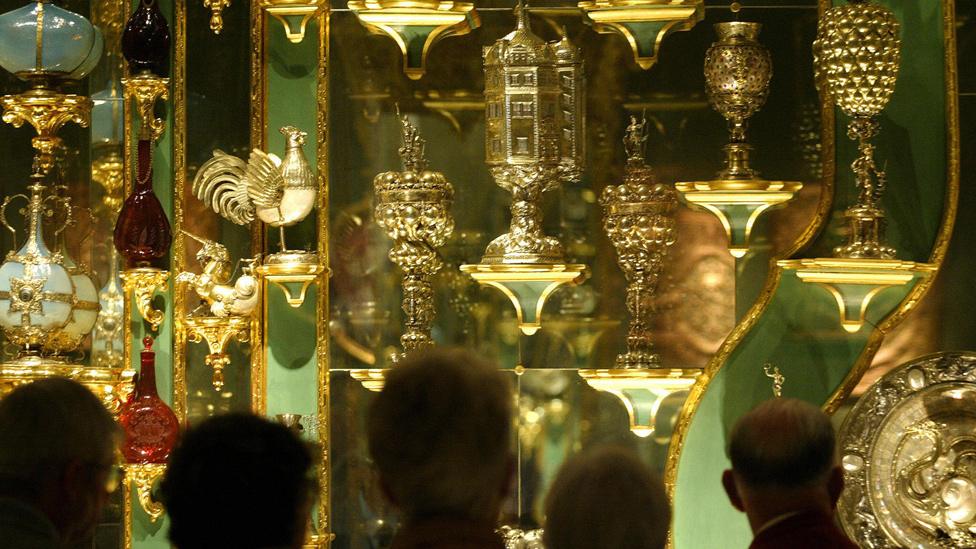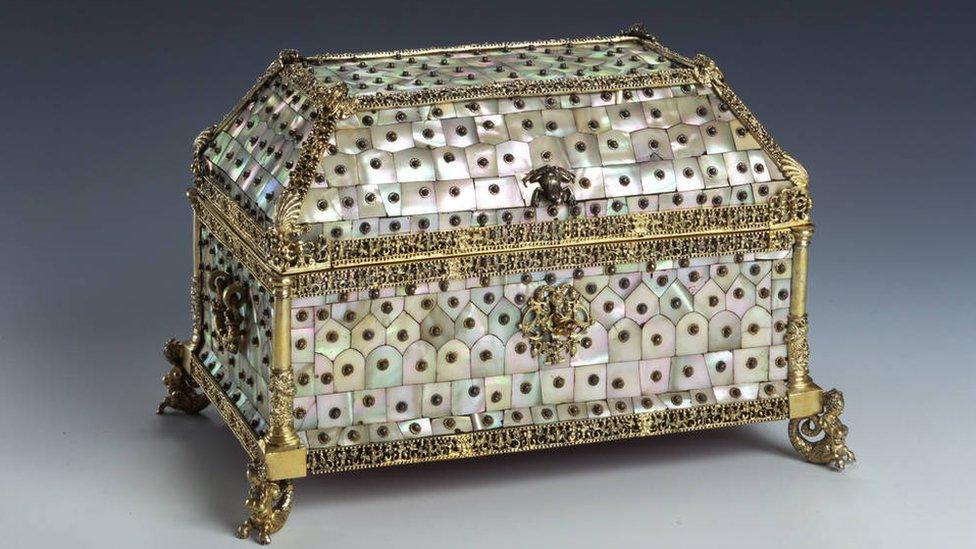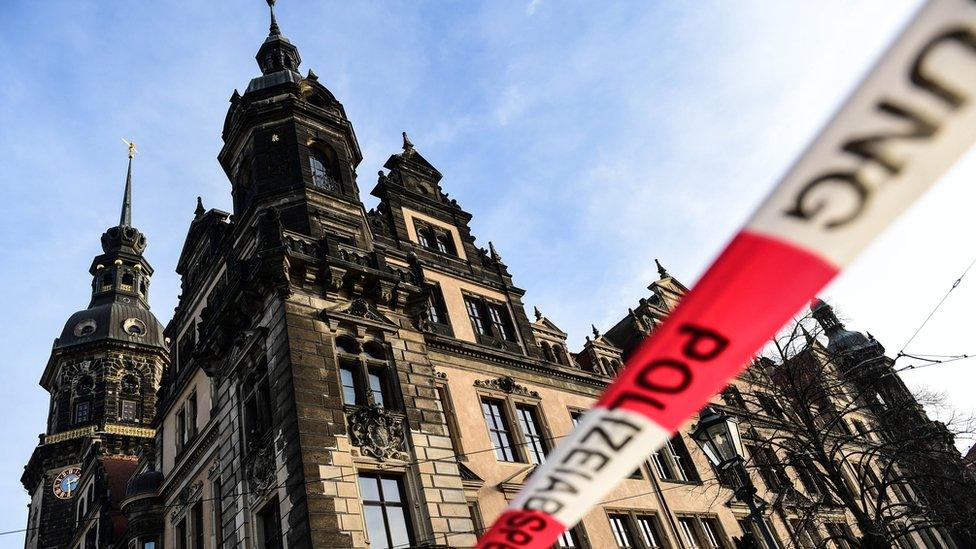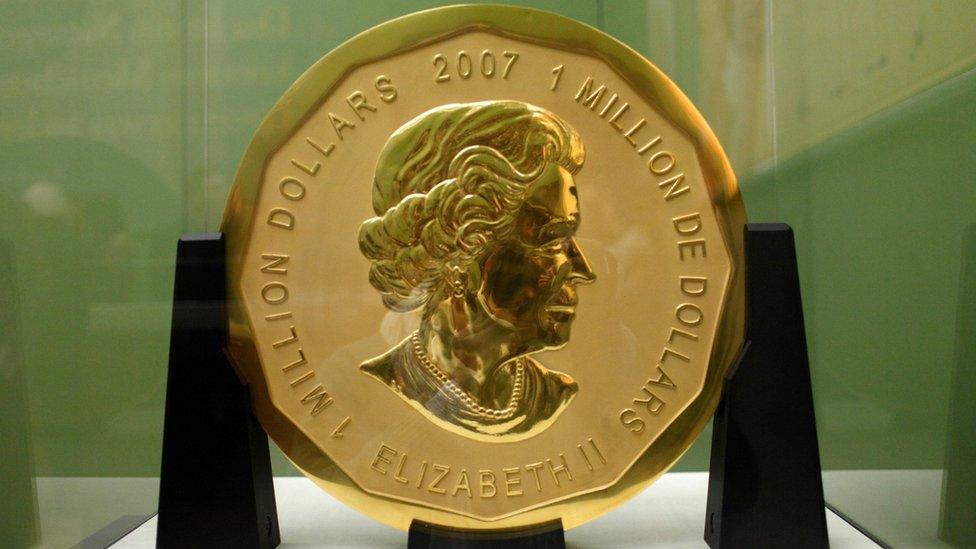Dresden Green Vault: Three arrested over German diamond heist
- Published
Security camera footage showed figures with torches and tools smashing one of the cabinets
Three people have been arrested over a dramatic diamond heist in Germany last year that targeted one of Europe's largest treasure collections.
The suspects are accused of stealing more than a dozen diamond-encrusted items from the Dresden Green Vault in the east of the country, police said.
Saxony's ruler, Augustus the Strong, created the collection in 1723 in what is one of the world's oldest museums.
Police have also raided homes in Berlin as part of the investigation.
"The measures today are focused on the search for the stolen art treasures and possible evidence, such as storage media, clothing and tools," a statement said.
Some 1,600 officers were involved in raids across several German states. The three held are believed to be members of a notorious criminal family network based in Berlin.
In a statement, prosecutors said all three were accused of "serious gang robbery and two counts of arson". They are set to appear before a judge later on Tuesday.

Homes, garages and vehicles were all searched by police on Tuesday
Three jewellery sets are believed to have been stolen from the Green Vault (Grünes Gewölbe) in last November's daring heist, reportedly including rubies, emeralds and sapphires.
Other items that were stolen included a diamond-encrusted sword and a shoulder-piece containing a famous 49-carat Dresden white diamond.

The Green Vault is a world-famous treasure collection
"The items cannot be sold on the art market legally - they're too well known," Marion Ackermann, the head of the Dresden state museums, said shortly after the robbery.

Germany's war on 'clans'

The spectacular raid on this treasure trove may yet intensify pressure on the authorities who've been accused, until recently, of turning a blind eye to the criminal family networks operating in Berlin and parts of north-western Germany.
The three suspects are said to be members of one so-called "clan" - families with Arab roots responsible for major organised crime including, in recent years, a raid on a department store and the robbery of a bank.
Three members of a clan were also jailed earlier this year for the theft of a giant gold coin from Berlin's Bode Museum.
A couple of years ago, police and politicians declared war on the clans and changed the law to target members who had traditionally laundered the proceeds of crime through the purchase of property. That may be small comfort to Germany's museum authorities.
The golden coin - deemed irreplaceable - was never recovered and is believed to have been melted or broken down. It is widely acknowledged that the precious items stolen from Dresden, which are impossible to sell legally because of their fame, are likely to have suffered the same fate.

On 25 November last year, in the early hours of the morning, the thieves removed part of an iron grille on a ground-floor window and then smashed the glass to enter the museum.
They had earlier managed to partially cut power to the building, which may have disabled the alarm system, local media report. They are believed to have set a fire at a nearby electrical junction box.
Once in the building, one of the robbers broke into a display case with an axe, while another used various tools to gain access to another cabinet.
Police suspect that a car found burning in Dresden later that day may have been the getaway vehicle used by the burglars.
Investigators had offered a reward of up to 500,000 euros ($590,000; £450,000) for information leading to their arrest.
What is the Green Vault?
The collection is housed in eight ornate rooms in the Residenzschloss - a former royal palace.
Three rooms were destroyed by Allied bombing in World War Two, but after the war, the museum was restored to its previous glory.

The Green Vault houses treasured items such as this 16th Century Indian mother-of-pearl box
It is called the Green Vault because some rooms were decorated with malachite-green paint.
The most valuable items are kept in the palace's historic section on the ground floor.
The collection houses about 3,000 items of jewellery and other treasures decorated with gold, silver, ivory and pearl. They include a 648-carat sapphire - a royal gift from Russian Tsar Peter the Great.
Augustus the Strong served as Elector of Saxony (a German prince entitled to take part in the election of the emperor) and later king of Poland.
- Published25 November 2019

- Published26 November 2019

- Published10 January 2019
